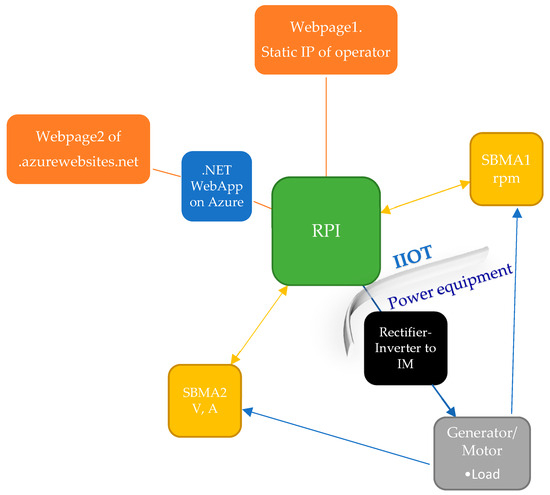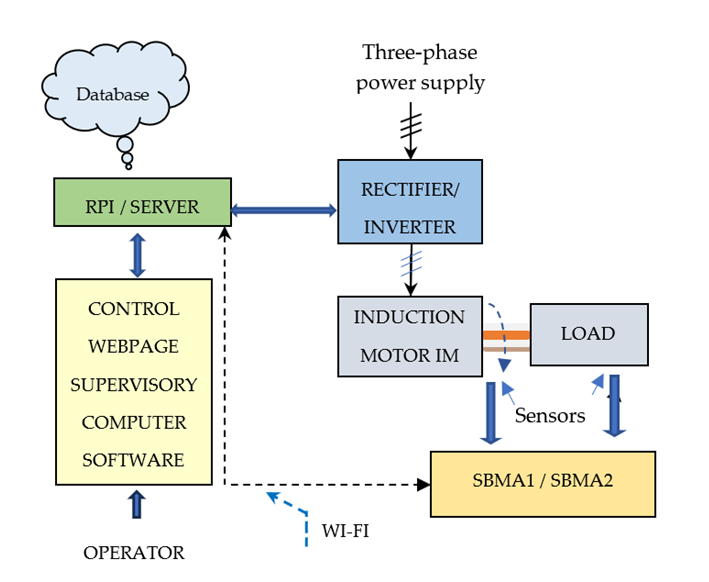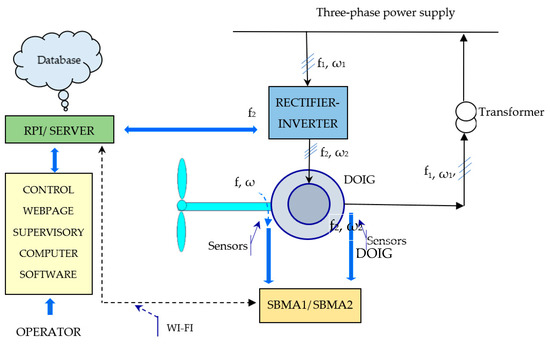The Internet of Things (IoT) is introduced in systems with electrical machines, such as in electric drive systems, wind energy generating systems, and small and special machines, to remote monitor and control the operation for data acquisition and analysis. These systems can integrate with the equipment and retrofit the existing installations. At the end of the control loops there are always motors, or actuators, of big or small ratings, of rotating or linear movements, electrical or nonelectrical, which must produce the motion. With the IoT-based control of induction machine systems operators can remotely monitor parameters and obtain accurate real-time feedback during fast changing duty cycle operation. Thus, IoT creates multipurpose instruments in the remote control of induction machines.
1. Introduction
The technology of Internet of Things (IoT) connects online to the internet and integrates devices. The IoT networks different kinds of physical objects equipped with electronic modules, acquires and transmits data, allows access to devices in remote areas, and the users can monitor their operation in real time. The development of IoT technology led to the emergence of new systems which are monitoring and controlling remotely complex structures. Operators can remotely monitor multipart installations, without human presence in the space where systems are sited. The interaction between machines, actuators, systems, sensors, and displays, has developed smart manufacturing applications which generate big volumes and diversity of data. Nevertheless, at the end of the control loops there are always motors or actuators, of big or small ratings, of rotating or linear movements, electrical or nonelectrical, which must produce the motion.
Recent reports present the advancement of IoT from an interdisciplinary viewpoint, like hardware and software of computers, control systems, sensors, and networks, and for a wide range of sectors. The IoT entered in to modern life by connecting smart devices, technologies, and applications. The principles of operating IoT, and its enabling of communication technologies, internet communication protocols, cloud computing, and big data analytics are applications and research topics of interest
[1].
Thus, new emerged industrial applications established the Industrial Internet of Things (IIoT)
[2] that connects different components of industrial equipment using sensors, and with the use of software, transmits large amounts of data. The acquired data are processed creating smartness. Related topics of smart processing are IoT-assisted manufacturing, which uses cloud computing, big data, and ICT
[3]. The introduction of IIoT in industrial sectors stimulates industry growth, involving smart machines with embedded sensors, connectivity, and managing acquired data for various applications with electrical machines. IIoT connected systems allow the operators to real-time monitor the status of electrical machines, give fast feedback and regulation, and thus, optimize production processes in factories. Already, applications of IoT found in places in many sectors of technology and life, are installed in embedded devices, in smart grids, for environmental monitoring in agriculture, in construction of buildings, in automotive industries, and in health care
[4].
Applications of IoT in smart grids of energy generating systems are parts of the Internet of Energy (IoE), which has roles in monitoring, remote control and management of installations, and equipment of electric generators, such as in Wind Energy Conversion Systems (WECS) of Renewable Energy Sources (RES) generation units. Because renewables depend on climate and weather conditions, the size and quality of energy produced from renewables are variable, and moreover, have high production costs. Thus, the various RES electricity generation devices, whether connected to electricity grids or stand-alone electricity systems, must provide for the possibility of improving the quality of the power produced
[5]. Other weaknesses are meeting the increasing demand of electric power by RES in a reliable and efficient way. In order to achieve consumer demand for electricity when produced by hybrid schemes with RES, fossil fuels, and backup storage, new low-cost power generation schemes need to be further explored
[5][6].
Along with advances in WECS design, construction, and sizes, the wind energy industry has also progressed due to Industry 4.0, which improves performance, processes, and computing power, making it easier to acquire and process data for automation, optimization, predictive maintenance, and new applications [4Mal]. Other aspects of IoT-enabled energy systems are architectures and functionalities of smart grid systems, with focus on communication, networking, computing, sensing, and security, which make them more robust, secure, efficient, and reliable,
[7].
The energy sector change from a centralized to a decentralized system, by unifying big and small energy producers and RES producers, and using ICT and IoT technology, must reach net-zero emissions sustainability goals
[8]. In various enterprises, by using actuators and sensors to collect and analyze real-time data, IIoT modifies the operation of machines and devices so that they do not require human intervention. Then, based on data collected and stored in real time, IIoT supports decision making, and uses this data for periodic assessment and maintenance forecasting
[9]. Thus, applications through IIoT contribute to the automation of industrial production, the management of business processes, and the transportation of goods and people. The IIoT offers the improvement of human labor conditions, or even unmanned labor, especially in conditions where people can be exposed to hazardous agents and environments, such as toxic, explosive, or radioactive environments, in mining, underwater, or at heights
[9]. The United States energy management system included grid surveillance with specifics on: weather and the impact of climate changes on energy generation and demand; forecasting of peak loads; renewable energy reliability and changeability; generation increase, decision analysis, and IoE integration
[10].
Operation and Maintenance (O&M) are significant parts of the lifecycle costs of manufacturing machinery and of wind plants. In offshore wind farms, the condition monitoring instrumentation is used for fault identification and improvement of performance
[11]. The state-of-the-art in O&M comprises offshore wind plants, WECS condition monitoring, deterioration models, fault diagnosis, prognosis, aspects of planning O&M, using artificial intelligence, data processing, integrating technology, automation, digitalization in the offshore maintenance sector, and debating the benefits, limitations, and application of these approaches with IoT and Industry 4.0
[11].
As far as developments in building infrastructure are concerned, energy installations using IoT are notable
[12][13]. Some of the elements of IoT are installed from the design phase and concern building control devices, such as sensors, hardware and software, monitoring and data collection to predict energy consumption
[14], supplying appliances with electricity, optimizing energy use, and ultimately improving the quality of life of residents
[12][13].
In industrial plants, induction motors (IMs) are installed as varying speed-varying torque actuators, with good performance and reliability under many operating states and duty cycles. Modelling approaches of control configurations include mathematical equations, numerical analysis, computer simulations, results for the evaluation of induction motor parameters, the behavior obtained when different control techniques are applied
[15], and the basic components for online monitoring of electrical equipment with electrical machines using IoT
[16].
Among the important areas of IoT use related to electrical induction machines are process control with remote operation and status monitoring, equipment fault diagnosis, and power generation control. There are other fields such as education, buildings, and medicine as well. An early detection can be based on an online automatic fault diagnostic technique for the maintenance of induction motors using the IoT
[17]. The benefits of induction motor controlled systems with IoT are optimized performance, reduced costs for O&M, increased reliability, and accuracy in prediction of failures.
To enable the introduction of WECS in the IoE and the conversion of wind energy, WECS technologies and their design are transformed into decentralized structures, methods, and technologies to cover electricity generation, and depending on load requirements and weather fluctuations, to include the characteristics of cyber-physical systems: security, remote control, networking, life cycle growth, and sustainability
[18]. There is a tendency to deepen knowledge of double-output induction generator DOIG control systems operating in WECS. Thus, WECS equipped with DOIG have the advantages of operating with variable rotational speed input and constant frequency output and applying the techniques of maximum power point tracker MPPT, control the generated voltage, frequency, active, and reactive power
[19]. The dynamic states of power systems embedded with smart grids and instabilities due to unpredictable wind and load changes, which can cause temporary load rejection, can be addressed using artificial intelligence and forecasting to predict component failures, reduce diagnostic time, and increase accuracy and stability for DOIG
[19].
The development of IoT has raised new issues for energy conversion to power IoT components and devices, such as nanogenerators, with lightweight simple construction and to make them self-driving
[20]. Nanogenerators can be piezoelectric, triboelectric, or pyroelectric. Thus, the sensors connected to the IoT can be powered using nanogenerators instead of conventional power supplies.
In Table 1 are the selected generic topics regarding electrical machines, working as induction motors and as induction generators, and their IoT-based specialized control systems for industrial applications and for WECS in energy generation power plants.
Table 1. Generic topics regarding electrical machines with IoT-based control systems.








